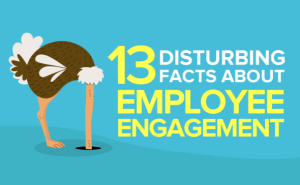You hear about the Future of Work and you think, “Yes, there must be something better than where we are. I feel it and know it is out there. But what does it look like? How does it work?” Do you want to take your company to a higher level? Do you want to transcend the problems that you have today and replace them with sound maxims and principles? Of course you do. But what are they? What does a company which works in the “Future of Work” do differently than what you are doing today? Here are 11 characteristics of companies who are already living where you hope to be. These characteristics come from examples of living, successful (and often very large) organizations that are in operation today.
DISCLAIMER #1: Not all companies have all of these characteristics, but they have at least a majority of them. Each company is different in the way it operates, but there are threads that run through them all. (And there are many companies that advancing toward these models that have picked up only a few of these characteristics.)
DISCLAIMER #2: Don’t freak out. These are not pipe dreams. Companies actually work these ways with VERY successful results. And so can your company.
DISCLAIMER #3: As you read these, remember when one thing changes, it has a cascading effect that changes the status quo and allows you to do things you have never been able to do before.
11 Characteristics of Future of Work Companies
#1: Everyone has the power and authority
To do what? To do whatever needs to get done. To purchase a tool (including one that is over $100,000), to hire someone if they need it, to change roles without another’s approval, to do something for a customer that is outside of the norm. It frees the employee up to not only do the right thing, but to take on a role that plays to their strength. Do this, and you can unleash the talents of each employee organically, instead of trying to force it out with another program. Give them that trust and you would be surprised what they can accomplish. In addition, if everyone has power and authority, you can’t tell another person what to do. Let that sink in for a minute…
#2: No org chart
“What?! No org chart? That seems like a recipe for chaos! Can a large company with tens of thousands of employees not have an org chart?” Actually, yes. Org charts show who has the power. But when everyone has power and authority to do what is best, you can’t contain someone in a box. Rather, you can clump groups of people around a specific function, but then realize that each person on that team may have an expanded scope that has nothing to do with that function. These groups of people are self-created and self-managed. And they may be fluid and may change as business needs change.
#3 No traditional job descriptions
If there isn’t an org chart, you might guess that there are no job descriptions. But that doesn’t mean that people don’t have very specific roles and goals to which they are held explicitly accountable to. Instead of boxing them in, the job functions have the ability to be fluid when needed, but they may be very specific as well.
#4: No traditional management
If everyone has power and authority, and job descriptions don’t exist, then what do the managers, directors and VPs have? Actually, you can’t answer that question because it doesn’t fit in this world. The way the Future of Work is organized, there aren’t any managers, directors or VPs. They are not needed. It seems odd that a company can function without these roles. This is contrary to everything we have not only been brought up with, but have been taught in school. It brings up so many questions that I can’t get into right now. But let’s just say that it is not only possible, but it happens. Successfully. In a very organized way that empowers employees. They are even held MORE accountable for their roles without management.
#5: No HR department
Can you imagine that?! No HR department. Think about that for a minute and you might go through a range of emotions, starting with “Hallelujah!” to, “Oh my goodness, could we even survive?” The answer is YES. “Who would hire and fire? Who would limit the number of people that could be hired?” The answer is you. (In fact, one company’s employees have gone so far as to outlaw the practice of firing anyone.)
#6: “That’s not my job” doesn’t exist
It can’t wait for someone else to do. If it needs to get done, do it. Whether the employee does it or puts together a team to get it done, if the employees feel like it is necessary, it gets done. Why? Because they have the power to do so.
#7: You work for what is right
In most companies, the bottom line always comes down to, “What is best for the stakeholders?” In the Future of Work companies, “What is the right thing to do” is what guides their actions.
#8: Conflict is encouraged
If the guiding star for us to follow is “What is right,” you can imagine there will be debate and conflict – as there should be. What is “right” may change as situations, industries, culture, and physical environments will change. But there is a healthy way to deal with conflict in these organizations.
#9: Meetings are optional and open
No one is mandated to go to a meeting. And at the same time, all meetings are open with the understanding that anyone can join the meeting. There is nothing to hide, nothing is done in secret. “Even if there need to be layoffs?” Yes, even then.
#10: All information is open
If all meetings are open, so is all the information. The strategy. The financials. The employee evaluations. The salaries. All the things that make most managers squirm if they were to share with the employees actually empower and strengthen the employees who work in this style of organization. Because they have all the information they need, they can make sound decisions.
#11 Employees feel free & trusted
Wow. What a change. Rather than feeling like a cog in the machine or a box on a chart, they feel liberated – free to be an adult and make good judgements. Trusted by all those around them to make the right decision for all those involved.
Is it possible?
Yes, it is possible for your company to work this way. It is a big change, but a change that is worth it. Why? Because the way in which we manage our companies today has hit the ceiling in effectiveness. To go beyond where we are today we must work differently – in a way that unleashes the potential the current management practices are unable to unlock. The reason not all companies pick up all these practices is because they are all different. You will need to find out which are best for your company.
 13 Scary Statistics on Employee Engagement
13 Scary Statistics on Employee Engagement Have you found ‘your thing’ yet?
Have you found ‘your thing’ yet? THE MANY PERKS THAT COME WITH QUITTING YOUR 9-TO-5 JOB FOR YOUR SIDE BUSINESS
THE MANY PERKS THAT COME WITH QUITTING YOUR 9-TO-5 JOB FOR YOUR SIDE BUSINESS










